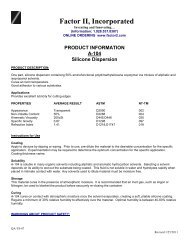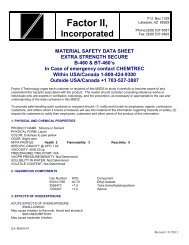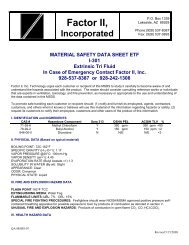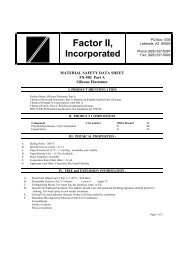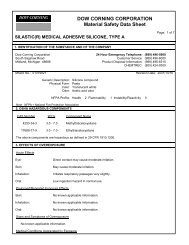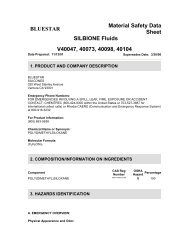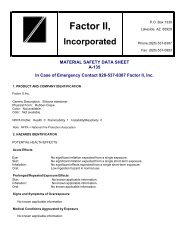Extrinsic Coloring Techniques.pdf - Factor II, Inc.
Extrinsic Coloring Techniques.pdf - Factor II, Inc.
Extrinsic Coloring Techniques.pdf - Factor II, Inc.
Create successful ePaper yourself
Turn your PDF publications into a flip-book with our unique Google optimized e-Paper software.
<strong>Factor</strong> <strong>II</strong>, <strong>Inc</strong>orporated<br />
Inventing and Innovating…<br />
(Information: 1.928.537.8387)<br />
ONLINE ORDERING www.factor2.com<br />
EXTRINSIC COLORATION<br />
Historcally there are numerous solutions to the final extrinsic coloration process necessary to create a final<br />
seal over the intrinsic coloration applied to silicone prosthesis.<br />
<strong>Factor</strong> <strong>II</strong>, <strong>Inc</strong>. has always been an advocate of sealing an addition cured silicone based prosthesis with the<br />
same material the prosthesis is manufactured from which we still believe to be applicable in the field.<br />
This has the advantage of the final product being made of one consistent chemically compatible material<br />
without the possibility of contaminating the silicone.<br />
There are however certain restrictions to this process, which at times will call for an alternative action plan.<br />
Which is still an effective process with most Silicone Elastomers. This is due not only to the various silicone<br />
that are chosen for the prosthesis, but also the additives which may effect the bond to the base silicone<br />
elastomer.<br />
On completion of the extrinsic coloration<br />
to the patient’s satisfaction, it is<br />
necessary to seal the coloration with<br />
silicone.<br />
A-564 has been proven to be an excellent sealing silicone with extremely high adhesion properties. This<br />
one part acetoxy silicone elastomer has a lower viscosity than the typical acetoxy systems on the market.<br />
Low viscosity, low durometer of 28, high tear of 100 ppi. The A-564 is translucent and possesses elevated<br />
cohesive properties, bonding silicone to silicone.<br />
The first step is to prep the surface, wipe the appliance with a thin wash of acetone to eliminate any<br />
residual mold release or topical oils from handled and debris from cleaning the seams (grinding). The<br />
prosthesis is then painted using FE extrinsic colors; this is similar water coloring a surface. Once the<br />
coloring is satisfactory, it is ready to be sealed. Cleanliness is imperative, once the prosthesis is preped do<br />
not handle it again.<br />
The prosthesis is painted with the TS-564 solution.<br />
This is carefully applied so as not to disturb any of the extrinsic<br />
coloring. This thin layer will cure in a reasonably short time. A little<br />
heat and humidity will accelerate this process.<br />
The TS-564 is a diluted version of the A-564 this creates a very tenacious<br />
sealant, which is being applied over extrinsic painting this however may<br />
create a glossy surface which is typically not desired and must be taken one<br />
additional step to establish a matte finish.<br />
QA-TS-07<br />
Revised 7/1/2010
<strong>Factor</strong> <strong>II</strong>, <strong>Inc</strong>orporated<br />
Inventing and Innovating…<br />
(Information: 1.928.537.8387)<br />
ONLINE ORDERING www.factor2.com<br />
Matte Finish<br />
Once the layer of TS-564 is dry to the touch, a very thin additional layer of A-564 is now applied, this layer<br />
is matted using slightly damp gauze, (the damp gauze will accelerate the set to the acetoxy surface, and<br />
texture the surface) it is very important to keep the layer of silicone thin. Ensure that there is no water<br />
visible on the silicone.<br />
The final step is to agitate the bottle of MD-564 pour 10 gms into a<br />
polypropylene mixing container by weight, add 2 gms of A-564 to the MD-564<br />
as a curing agent mix together until the A-564 dissolves into a solution. The<br />
final step is to paint a thin coat of this mixture onto the surface to matte any<br />
gloss that may have been created in the sealing process.<br />
Avoid touching the surface of the prosthesis as this result in blemishes after curing.<br />
If a “frosted” look is noticed then the layer of MD-564 is too thick. Remove the layer with ETF fluid and<br />
reapply only thin layers.<br />
Proceed to cure the silicone, once cured<br />
wash the prosthesis with clear soap and<br />
water, dry and the prosthesis is ready for<br />
delivery.<br />
With the tests we have run to date we feel very strongly that the A-564, the TS-564, and the MD-564,<br />
will be an improvement over conventional sealing techniques especially in the application of the new VST<br />
series of silicone elastomers and the existing condensation silicone elastomers currently being used. All<br />
feedback on the practical use of this product, will be welcomed and appreciated, as we try to improve on its<br />
properties and uses!!<br />
John D. McFall jdmcfall@factor2.com.<br />
David Trainer detrainer@factor2.com<br />
QA-TS-07<br />
Revised 7/1/2010
<strong>Factor</strong> <strong>II</strong>, <strong>Inc</strong>orporated<br />
Inventing and Innovating…<br />
(Information: 1.928.537.8387)<br />
ONLINE ORDERING www.factor2.com<br />
Warning About Product Safety:<br />
<strong>Factor</strong> <strong>II</strong>, <strong>Inc</strong>. believes that the information and data contained herein is accurate and reliable: there is a<br />
certain degree of sophistication required to accomplish the process outlined in this document. It is the<br />
user’s responsibility to determine suitability and safety of use for these materials<br />
The outlined procedure with the new the 564 (series) are still in the experimental stage and <strong>Factor</strong> <strong>II</strong><br />
cannot take any responsibility for mismanagement on behalf of the user. We are actively in the process of<br />
testing this product clinically.<br />
QA-TS-07<br />
Revised 7/1/2010



